
Guests
- Dr. Theo Colbornsenior scientist with the World Wildlife Fund.
Amy Goodman interviews scientist and author Dr. Theo Colborn about endocrine disruption created by man-made chemical contaminants that interfere with, mimic, disrupt vital hormone and endocrine functions in both humans and wildlife.
Theo Colborn is the senior scientist with the World Wildlife Fund. She is an expert on endocrine-disruptive chemicals, co-author (with Dianne Dumanoski and John Peterson Myers) of Our Stolen Future: Are We Threatening Our Fertility, Intelligence, and Survival? A Scientific Detective Story. Dr. Colborn has given testimony before the U.S. Congress and lectured on college campuses. Theo Colborn has been called “the Rachel Carson of the Modern Age.” (Rachel Carson is the author of the book Silent Spring.)
Since the early 1920s, mankind and industry have released chemicals — over 500 of them have been found at harmful levels of concentration in human tissue — which were never there before. These chemicals include toxins leached from plastics into the environment; dioxins; furans; PCBs; harmful chemicals produced by burning plastic; fertilizers and pesticides — “beneficial” chemicals intentionally created to be persistent in the environment; industrial chemicals from smokestacks; and even chemicals released from “microwave-safe” plastic food containers heated in microwave ovens.
Many of these chemicals, some of which are passed from mother to child in the womb, can interfere with the “chemical messengers” which “tell” the body how to develop, and eventually affect the human nervous system, endocrine system or immune system, potentially affecting the health, development, behavior and intelligence of any human, anywhere. Dr. Colborn discusses albatrosses which live in open ocean 1,000 miles from any land, which have become as contaminated by plastics as birds in the Great Lakes.
Transcript
AMY GOODMAN: When was the last time you heard the major presidential candidates, Bob Dole, for example, talking about the toxic chemicals that threaten us, or President Clinton responding to the anti-NAFTA environmentalists saying that since NAFTA, over the last two years, that environmental standards have gone down in this country and have been worsened in places like Mexico?
Well, today, we’re going to get a lesson on what’s happening in the environment from what some are calling “the Rachel Carson of the modern age.” We’re joined now by Theo Colborn. Theo Colborn is the senior scientist with the World Wildlife Fund and a recognized expert on endocrine-disrupting chemicals, and she is co-author of a new book that is just out this week called Our Stolen Future: Are We Threatening Our Fertility, Intelligence, and Survival? A Scientific Detective Story. The book is so important that yesterday, before the release — yesterday, there was a press conference that she attended along with her co-authors, but the day before, the pesticide industry had their scientists come out, in force, to try to deal with some of the questions that were going to be raised when the book came out.
We welcome you to Democracy Now!, Theo Colborn.
THEO COLBORN: Thank you for inviting me to be here.
AMY GOODMAN: Well, why don’t you tell us about what is threatening our fertility, intelligence and survival?
THEO COLBORN: Well, Amy, since about 1920, we have released a large number of chemicals into the environment that were never in the environment before. You’re sitting there today with over 500 measurable chemicals in your body that no one had in their body before the 1920s. And we thought these chemicals were safe. We either thought they were inert, they wouldn’t affect us, or we thought they wouldn’t cause cancer or gross and obvious birth defects.
But what we understand now is that these chemicals pass from the mother to the developing baby in her womb, and they interfere with the chemical messengers that tell an embryo how to develop, how to grow, tell a cell where to move, tell a nerve cell how to develop. And we know now that we have chemicals in our bodies that can affect our children so that their endocrine systems, their immune systems, their nervous systems and their behavior and intelligence could very well be affected as a result of this exposure in the womb. You know, when you don’t build a house correctly, the foundation isn’t correct, the house is never sound. You don’t see pathologically sick children running around, but we may have children running around whose potentials are compromised.
AMY GOODMAN: And where are these chemicals coming from?
THEO COLBORN: Well, the original batch, of course, came out of the production of pesticides, organochlorine pesticides, that were made to persist for a long time — and, unfortunately, they’re still persisting. We’ve restricted the production and use of some of these in this country, but we haven’t around the world. There are large, large volumes of these chemicals being produced and released today in other parts of the world. And also we have industrial chemicals like the PCBs, that made your industry possible. Without the PCBs, we wouldn’t have electricity served to us today that we would have. They’re fire retardants. They have been very important in how we have actually improved our lifestyle. And, actually, our whole economy is based upon chemicals that do this.
Plastics, only recently — it’s really very interesting. It was only since we brought attention to this possible effect that in a laboratory, not — in Tufts University, on the eastern part of the United States, and Stanford University, on the West Coast of the United States, two separate labs, working under different conditions, found that two components of plastic actually leach out of the containers into whatever they’re holding and can affect — in this instance, these people were working with breast cancer cells of all things, and they were looking for reasons why breast cancer cells replicate. And their breast cancer cells began replicating, and they couldn’t figure out why. Well, they found out it was components leading out of the plastics that were holding these breast cancer cells.
AMY GOODMAN: You know, it’s interesting when you hear about, for example, the relation to breast cancer and chemical pollutants, because there have been some studies coming out now that link the two, although there’s a lot of emphasis we see in scientific studies on genetic makeup.
THEO COLBORN: Yes, mm-hmm.
AMY GOODMAN: But just politically, it’s very difficult to get this information out, because you have large PR firms, like Porter Novelli, that represent the industry and also represent the American Cancer Society pro bono. And so they get the American Cancer Society to put out statements that there are no definitive studies at this point linking breast cancer to toxic pollutants.
THEO COLBORN: Well, see, that’s an interesting point, because if we know now that certain cells during their developmental stages, or certain organs and tissues, like your secondary sex organs, the prostate, the testes, the breasts, OK, if during embryonic development an individual — in a laboratory, this has been demonstrated — if an individual is exposed to these chemicals that we’re talking about, they lay down more receptors in these cells as they start developing, so that they’re more sensitive later on, throughout life. It’s like a time bomb being planted in this developing embryo at that time, so that they not only respond, and these cells not only respond to the internally or the naturally produced estrogens in the body or the external ones, which we are adding to our body burden from our food, our air, our water, from our exposure to these kinds of chemicals. Now, if this is the case, you would not expect to find in a woman’s breast today, or in her fat, the chemical that actually induced her susceptibility to cancer. And that’s our big concern. How do you trace these things back?
The same thing applies to sperm count. There’s a reduction in sperm count today. In all probability, in many instances, that problem is a result of a male being exposed to elevated levels of estrogens during embryonic development or an anti-androgen, something that’s blocking the message that the testosterone is telling to that male’s testicles: You produce more Sertoli cells. Because when you reach adulthood, it’s the number of Sertoli cells that actually has a lot of control over the number of sperm you can produce.
AMY GOODMAN: We’re talking with Dr. Theo Colborn, and she’s co-author, along with Dianne Dumanoski and Peter Myers, of the new book Our Stolen Future: Are We Threatening Our Fertility, Intelligence, and Survival? A Scientific Detective Story. Now, the day before your big press conference yesterday where you released this book, there was another press conference that was held by a group of scientists, and they’re a group of scientists who call themselves the Advancement of Sound Science Coalition. Do you know about this group?
THEO COLBORN: Oh, yes, we know about this group.
AMY GOODMAN: Can you tell us who they are? Because these groups, like the Advancement of Sound Science Coalition, are playing a key role right now in Congress. In fact, many are saying they are writing the legislation, the anti-environmental legislation that is repealing regulations that have been laid down over the last decades.
THEO COLBORN: Amy, I really don’t know who these people are. That’s how apolitical I am. I work away from the political arena. I do my science, and I try to do it very objectively, and I never report on science that I haven’t discussed with the scientists who have done the work. So, I don’t know who these people are. I have seen the material that appeared in the paper, and in some of it, it’s really very interesting. I think they’re trying to cloud the issue. That’s about all I can say now.
AMY GOODMAN: Well, why don’t we play a little bit right now of a comment of one of the scientists yesterday who was speaking out, making reference to your book and the kind of information that was going to be coming out? His name was Jonathan Tolman. He’s an environmental policy analyst at the Competitive Enterprise Institute, and he was debunking the idea that man-made estrogen-like compounds affect the health of human beings.
JONATHAN TOLMAN: A great deal of attention now is being focused on the fact that synthetic chemicals have exhibited estrogenic effects in laboratory studies. The chemicals most prominently cited are PCBs and DDT, both of which have been banned in the United States. Compared with phytoestrogens, the concern over synthetic chemicals may be somewhat overstated. It takes nearly 1 million of these chemical — synthetic chemical estrogen molecules to have the same effect as one synthetic estrogen molecule, such as DES, which is what is in most — the pill, essentially. Since total intake of these pesticides is significantly lower than the naturally occurring phytoestrogens, the estrogen exposure from synthetic chemicals has been estimated at .000025 microgram estrogen equivalents per day. In other words, the estimated estrogenic effects from plant estrogens in our diets is 40 million times that of the synthetic chemicals.
AMY GOODMAN: So, of course, his main point, this scientist, who was brought out by the Advancement of Sound Science Coalition — his main point is that naturally occurring toxins and estrogens are actually more harmful than the toxic chemicals you’re talking about.
THEO COLBORN: Well, let’s start at the beginning here. We do know that there are plant estrogens that we have evolved with. Mankind has evolved with these plants, and we have been exposed to these plants over a lifetime. And those individuals who were affected by the plants were sort of weeded out of our society. We are the survivors that are left, that have the defense mechanisms to deal with plant estrogens. Why is it that — and remember now, the chemicals I’m talking about have only been introduced into the environment — what is it now? 1990? — about 70 years ago. We started becoming exposed to those. We have had no chance to evolve with those chemicals. And the interesting thing here is also it looks like the chemicals that we have introduced into the environment, these man-made chemicals, actually do an end run around the body’s mechanism that the body has evolved with to protect us from these kind of chemicals, so that they slip into the embryo, they get into the developing embryo, and they do have an effect.
AMY GOODMAN: Why are they called hormone-disrupting chemicals?
THEO COLBORN: Well, OK, just you sitting there right now, you wouldn’t be alive if you didn’t have hormones telling your cells what to do, how to function. These keep us alive. They control your metabolism, your intelligence, you know, your body heat. Hormones are very, very important. And there are a lot of these operating in your body, but at extremely low concentrations. I mean, you would have to be monstrous if, you know, we had to have lots of hormone with us.
Now, these hormones that we have introduced, these chemicals we’ve introduced into our system today, and now we’re getting into our body, look like or interfere with the ones that are naturally there, that tell us how to function, tell an embryo how to develop. And that’s called disruption. It’s disrupting the message. So, basically, we’re getting garbled messages on how to develop and how to form.
Now, think of thyroid hormone. Thyroid hormone is critical for the development of the brain, and there are a number of chemicals out there. It’s been demonstrated in the laboratory. We actually know the mechanisms how these synthetic chemicals interfere with the transport of thyroid hormone in the system, how they interfere with enzymes that convert the thyroid hormone to a more active form. We’ve got all these models in the laboratory, and we’re seeing the same thing in the field, in animals. And now what we’re asking for is a research agenda to see if these are not some of the things that are contributing to such things as attention-deficit/hyperactivity disorder.
AMY GOODMAN: How?
THEO COLBORN: Because there are genetically deprived individuals. A very small percentage of the children with ADHD have a genetic deficiency, and their deficiency is called thyroid hormone resistance. They can’t respond to the thyroid hormone. Then we have a whole bunch of other kids out there that have HDHD, but there’s no explanation for it. And this is what we want to work on now. Could it be that these children had had — were exposed to enough of these kind of chemicals during embryonic development so their brain just didn’t get wired the way it should be? And so, we use the model of the genetically disturbed child as an example of how now to study this. And we need research put into this. This is very, very important.
AMY GOODMAN: We’re talking with Dr Theo Coborn, again, who is co-author of Our Stolen Future: Are We Threatening Our Fertility, Intelligence, and Survival? A Scientific Detective Story. She’s being hailed as the Rachel Carson of our age, 30 years after Rachel Carson wrote her incredible book, Silent Spring, to alert us to the dangers of DDT and DDE. The industry certainly came down hard on her, trying to discredit her work. She suffered with that for many years. And now this new book, Our Stolen Future. Now, in Tuesday’s New York Times, in the science section, there was a very interesting piece, “Old Nemesis, DDT, Finds Remote Albatrosses.” And it’s about a study that your organization, the World Wildlife Fund, actually funded. Now —
THEO COLBORN: No, no, we didn’t fund it.
AMY GOODMAN: Or, were involved with?
THEO COLBORN: We designed it. It’s our study. We created it. And then we were able to get support from EPA to do the study.
AMY GOODMAN: Sorry, I guess I had funds on my mind —
THEO COLBORN: Yes.
AMY GOODMAN: — because last year, the study was halted because of budget cuts at the EPA, canceling a final season of field work. But finally, the research has been published. And I was interested, considering that this is an election show where we talk about politics every day, about how, when you talk about sustainable development and when you talk about environmental issues, it really cuts across the political rhetoric, and it really cuts through it, because political rhetoric is about short-term gain. You can introduce legislation, you can get it passed, and then you don’t have to deal with the consequences of it. And here, in this piece, it talks about one of the scientists, talks about how our research demonstrates that global controls on the distribution of persistent, bioaccumulative toxic compounds need to be considered. The problem can’t be approached on a country-by-country basis.
THEO COLBORN: Exactly. One of our concerns today is that people are reaching a background level, in a number of the industrialized nations, of concentrations of these persistent organic pollutants, the ones that we released, and these chemicals are in everyone’s bodies. DDT breaks down to DDE, and this is what you find in human tissue. You find PCBs.
The interesting thing here is that we went to the North Pacific. We thought we’d pick the biggest, deepest, most pristine pot of water on Earth to see if these chemicals were really a global problem. Did we need to do something about it? All the predictions from land-based work and the Great Lakes works predicted yes, but we wanted to be sure. We found that these birds that feed only in the mid-ocean have concentrations of DDT in their eggs now, when they go back to Midway Island to nest.
AMY GOODMAN: This is what? Like a thousand miles away from Hawaii.
THEO COLBORN: That’s right, yes, north of Hawaii, and that we think is clean water. You know, these birds actually have concentrations of DDT in them. And we know it’s fresh DDT. You can tell by the breakdown products as you do the chemistry. The chemists know this is fresh DDT coming into the system.
The other thing that’s very interesting is, too, here is that these birds have elevated concentrations of furans and dioxins in them compared to the birds in the Great Lakes. Now, furans and dioxins come from the combustion of products that have chlorine and organic material in them. This is mid-ocean. We didn’t think that these things blew on the wind that far out into the ocean. We do know ocean currents mix. And remember, these birds feed only on the surface of the ocean.
AMY GOODMAN: Are we talking about incinerators?
THEO COLBORN: We’re talking about incinerators, burning. The plastics we find in the bellies of these chicks when the parents come back, they’re picking food off the surface of the ocean, and they regurgitate plastics into the baby chicks. And these are partially burned plastics. That’s how you produce dioxins. You know, it’s very interesting. There is an international effort on this, and I am very excited about it. I’m really pleased.
AMY GOODMAN: We’re talking to Dr. Theo Colborn. We’re going to come back to her in just a minute, again, co-author of Are We Threatening Our Fertility, Intelligence, and Survival? It’s times like this that I wish we could open the phones right now and take your calls. Coming up after our musical break, we’ll continue with Dr. Colborn and then move on to a discussion, a debate on counterterrorism, the counterterrorism bill that was just passed by the House. Is it about terrorism, or is it about something else? But first this.
[break]
AMY GOODMAN: You are listening to Democracy Now! I’m Amy Goodman. Democracy Now! is Pacifica Radio’s national daily grassroots election show. Actually, I’m headed down to Baton Rouge for the weekend, where I’m going to the conference on dioxin. And we’ll be bringing you some of the speeches from the people, the activists from around the country. There are more than 450 of them who will be gathering to deal with that issue in this country, dealing with issues of environmental justice and environmental racism. There seems to be efforts now to encourage industry to actually locate — they’re getting tax breaks — locate in poor urban centers. They talk about jobs. Often the environment issues are pitted against jobs. We’re going to go on with this discussion of the environment, and then we’re going to be talking about counterterrorism. Is the bill that’s just been passed by the House — is it an effort to actually counter terrorism? But right now, again, our guest, Dr. Theo Colborn, she is a senior scientist with the World Wildlife Federation, the World Wildlife Fund, here in Washington, D.C., and she’s co-author of the new book, Our Stolen Future: Are We Threatening Our Fertility, Intelligence, and Survival? A Scientific Detective Story. What’s happening internationally, Dr. Colborn, on the issue of controlling these endocrine disruptors?
THEO COLBORN: It’s very interesting. It started in the Baltic countries, because they actually end up with a lot of these things blowing north getting into their water. They’re north of all the industrial activity in Europe. And they signed an agreement last summer to actually phase out, in one generation, by 2015, persistent organic pollutants and endocrine disruptors. That was picked up, and actually we had a big meeting here. Our State Department hosted it. Tim Wirth led it. And we actually got an agreement of more than a hundred nations signing on to start phasing out persistent organic pollutants, like the PCBs, the DDT, that I just talked about a minute ago. And they’re working on strategies now on how to proceed.
AMY GOODMAN: Which are the major industries that create these toxins?
THEO COLBORN: Well, for one thing, you know, the pesticide industry, of course, produces these things on purpose. I think the most recent findings, that plastics that we thought were benign may not be benign, is a very big issue. And these industries are beginning to go back and redesign their products, look at what they have, go back to base one. We realize now we’re going to have to test everything that we’re going to put out into the environment.
AMY GOODMAN: But industry fights you every step of the way.
THEO COLBORN: Of course. But I know they’re working on it. I have seen response already. So…
AMY GOODMAN: What do you mean?
THEO COLBORN: Changes in products, advertising on television, telling us how good a product is. We know industry is aware of our message. If they’re aware of our message, they know that if they can design a product that they can release to the public, put up for sale, and say, “My product is biologically benign. It’s not going to affect the future generations,” they will have a product that is competitively ahead of anyone else, and with international action like this, they’ll have a product they can sell globally.
AMY GOODMAN: What about Britain? Where do they stand in this worldwide effort?
THEO COLBORN: Well, unfortunately, Britain did not sign on to the North Sea Treaty last summer. The eight Baltic countries did, but Britain did not.
AMY GOODMAN: Why not?
THEO COLBORN: I really don’t know. I know there are a number of people working over there doing some of the leading science in the field of male reproduction, detergents in the environment. They’re looking at detergents, plastics. They’re a big help. They’re really — the scientists, the scientific community knows this. Let’s put it this way. And this is general knowledge worldwide among the scientific community. And I think as we reach out and reach our policymakers and concerned people, we’ll see changes.
AMY GOODMAN: Are you at all dismayed by the lack of discussion of environmental issues at the presidential campaign level?
THEO COLBORN: Oh, yes, I sit there every time I hear a speech or look at what’s in the paper and think, “Don’t they realize that our underlying wealth is in our natural resources and in our children, and we have got to take them into consideration?” Until we consider environmental issues in everything we do, we are not going to have a very healthy, happy world to live in.
AMY GOODMAN: Have you ever been called to testify before Congress?
THEO COLBORN: Yes, I have.
AMY GOODMAN: On what issue?
THEO COLBORN: This issue. I’ve been talking about this since 1988, I believe. No, it was ’89 when I first started testifying.
AMY GOODMAN: And what direction do you think politics in this country are going, and legislation is going, to increase the kind of endocrine disruptors that you’ve been describing and dioxin in the environment?
THEO COLBORN: To increase them? I think that’s the way the legislation looks right now. It’s very gloomy. We have got to give more support to EPA. EPA needs help on this. They’re aware of the problem. The public thinks that there are a lot of people out there protecting them. They think we have big laboratories, and everything they touch is safe. Little do they know the trivial amount of money that’s going into assessing the safety of the products that they’re exposed to every day.
AMY GOODMAN: What about the effect of industry on academic research? I mean, a couple of weeks ago, we were talking with John Stauber, who wrote the book, Toxic Sludge Is Good for You, about the PR industry. And we were talking about one of the new products that’s out on the market, olestra from Procter & Gamble. They are pouring millions of dollars into PR around this fat-free molecule, this molecule that’s too big to go —
THEO COLBORN: That’s right.
AMY GOODMAN: — into the body, and so it just oozes right out. And one of the things we discovered was the amount of money that they are pouring into academic institutions. And then you, of course, get the scientists, the deans of community medical schools, you know, schools of community medicine, etc., actually endorsing the product, or at least saying it doesn’t create as much damage as you think. What effect does industry have on academic research, the academia you come out of?
THEO COLBORN: I see it more and more. I also think that there has to be more federal money moving into our institutions of higher learning so that we can avoid this kind of conflict. And it’s really very interesting, because as I began talking about these chemicals that don’t damage the gene — remember, the gene is not damaged here. All these chemicals do is tell the gene to do something at the wrong time, or not at the right time. So, and I’ve spoken to scientists about this, and they’ve said, “We love what you’re doing. We were doing research like this back in the 1970s, '79, but in order to keep our postdocs working, to maintain our technicians in our laboratory, we had to write proposals for other kind of research. And specifically, for many, many years, it's been strictly cancer.” Now, I don’t think that we should ever stop trying to protect ourselves from cancer. I think that’s very important. But they have all said this is the only way they could get money, was through specific, immediate problems, and not to what we need to have more done of, is basic research. We don’t understand how the natural system operates, and until we understand that better, we can’t deal with these kind of problems.
AMY GOODMAN: The direction Congress is going in now, it seems, from public broadcasting to public institutions, educational institutions, is to say private industry can do a better job of funding them.
THEO COLBORN: That’s what they’re saying. Well, that’s the way the — OK, that’s the way the cookie is crumbling today. I think we’ll see the pendulum shift back. I really do.
AMY GOODMAN: What is your strategy in getting the word out about Our Stolen Future?
THEO COLBORN: My strategy to get the word out? Well, to accept invitations from people like you, lecture on college campuses, still go out and talk to the scientific community. Once an open-minded scientist hears this story — well, generally, when an open-minded scientist hears this story, they understand it. We have a tremendous amount of scientists who are endorsing our book.
AMY GOODMAN: As we wrap up right now, can you tell us what you recommend to people, on an individual level and even on a community level, to protect themselves from these toxins that you describe in Our Stolen Future?
THEO COLBORN: Well, for one thing, be very careful about the water they drink, especially if you live in the middle part of the country or you’re dependent upon community or wells. We know the groundwater is contaminated almost entirely throughout the Midwest, where the agricultural chemicals have been poured into the ground. Also, we’re recommending to everyone, until you find out better, don’t heat your food in your microwave in plastic. Switch to glass temporarily, until you find out whether the plastics are safe.
AMY GOODMAN: How do you know?
THEO COLBORN: You don’t know, and that’s what we’re calling for in the book. We’re asking — we say the public has a right to know what’s in the products they’re purchasing and using, and we want the manufacturers to be able to put on their labels what is in the product, so then the consumer can make a decision about whether they want to use these products or not. And then, of course, be very, very discriminate about how you use pesticides and around your children. Grow dandelions. Don’t worry about dandelions in your lawn. Forget the lawn care products, that sort of thing. And form community neighborhood groups, if you want to keep your neighborhoods pesticide-free. You can do it. It’s happening around the country. And, of course, support the organic grower, or become an organic grower yourself. Buy as much organically grown produce as you can.
AMY GOODMAN: We thank you very much for joining us, Dr. Theo Colborn, who is co-author of the book Our Stolen Future: Are We Threatening Our Fertility, Intelligence, and Survival? A Scientific Detective Story. Get the information and then go out on the campaign trail and challenge the presidential candidates. This is your chance. This is your chance to get access to them. This is your chance, the one little window that you have before the presidential election, that maybe, possibly, you’ll get an answer to some of your questions.

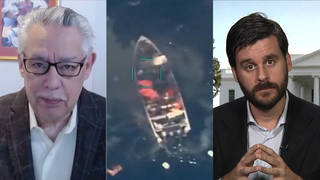

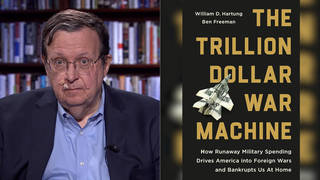
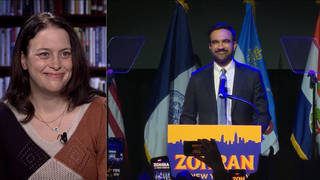
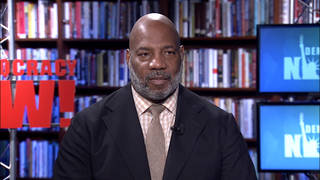
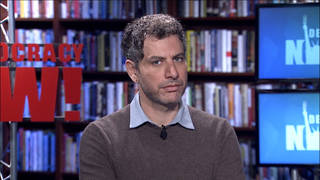

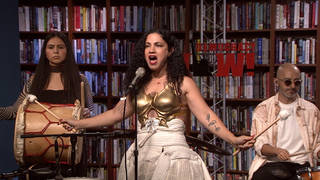

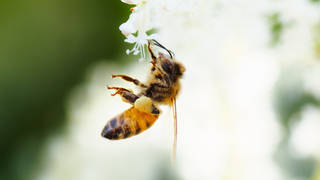
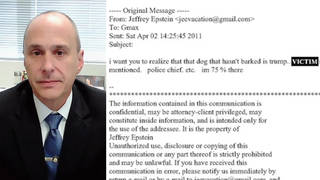
Media Options